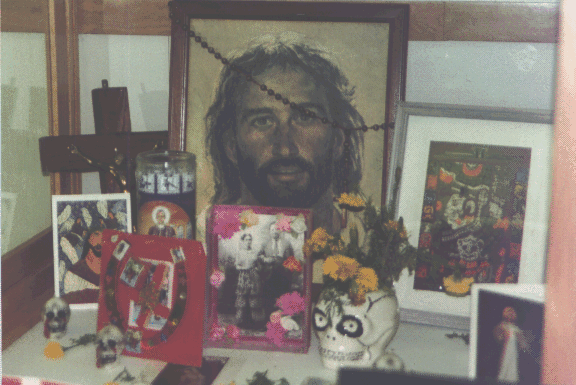The Day of the Dead

The Day of the Dead, as observed presently, had
its origins with the indigenous people of the American continent. It is a religious
holiday. A time to remember and honor the departed with joyous celebrations
rather than the somber sadness usually associated with death. Although the celebrations
include a mourning ritual called 'El Duelo" (The Weeping), the atmosphere
is one of happiness. It is the belief that on these days the dead join theft
families and loved ones, and that is cause for celebration. From Mexico to Ecuador,
indigenous people held celebrations in remembrance of the departed in various
forms. However, in most instances, as was the custom of the "Mexicas' (inhabitants
of what is now Mexico City), offerings were made which consisted of food and
other supplies that would help the departed make their afterdeath journey through
the nine underground passages. The successful passage through these undergrounds
led to their final resting place. There were three such places; the least desirable
of which was "Mictlan". According to the "Mexicas" value
system their afterdeath existence was predetermined by those acts performed
while alive that were pleasing or otherwise to their gods. Present day celebrations
occur during November 1 and 2. These dates coincide with the Catholic World
celebrations of All Saints Day and All Souls Day, respectively. This coincidence
in dates stems from the Catholic Church's efforts to find similarities between
the indigenous and christian beliefs that would aid the Church in converting
them to Christianity. The multiple deities of the "Mexicas" and other
indigenous people and the multiple saints of the Catholic faith certainly have
this commonality. This tradition is observed in urban and rural areas, however,
more so by the rural poor population. The urban middle to upper class might
have a simple home offering, or even scoff at the tradition. The rural and poor
classes have elaborate altars and offerings to the dead. Simple offerings in
homes, offices and graves are done with a flower arrangement of "cempazuchitl",
the Nabuafi language name for marigolds, and candles. Elaborate offerings combined
plates of tamales, a pie made of corn with varied fillings; beverages, usually
the favorite of the deceased including chocolate, tequ'fia or mezcal; an assortment
of flowers; candles; bowls of local fruits such as chayotes, limes, and avocadoes;
and "pan de muerto", rounded loaves of bread, sometimes human shaped
topped with a design of crossed bones. Marzipan skulls, bread shaped like a
skull, surrounding the picture of the deceased complements the offering. The
graves are adorned with flower arrangements and the area is covered with "cempazuchifl"
petals. Candles and copal incense are burned. The candle light along with the
penetrating fragrance of the incense help the returning souls find their way
back. People gather at these cemeteries and play music from homemade drums and
flutes. Street vendors sell a variety of fruits and delicacies which have become
a part of the folklore, the ritual and the celebration. They include: Pan de
Muerto, amaranth seed skulls with raisin eyes and peanut teeth, candied Marzipan
skulls, roasted corn cobs, and punch with chunks of fruit and rind. As the "Mexicas"
belief of dying a "flowery" death or the Christian one of dying "under
the grace of God", the souls rest in peace in heaven, "Mictlan"
or with the gods. The offerings of drink, the food with its wonderful aroma,
the burning copal incense with its penetrating fragrance, the guiding light
from the candles, and the drum and flute music are all enticements to the departed
to join the living in the celebrations of, not death, but the continuum of life.

